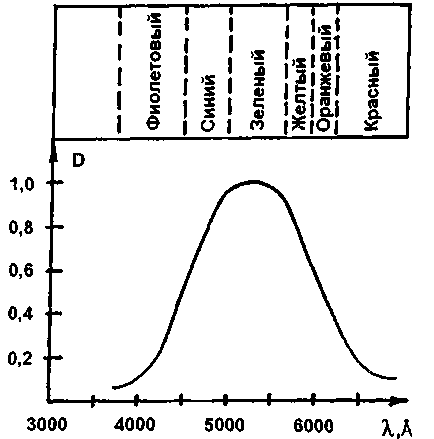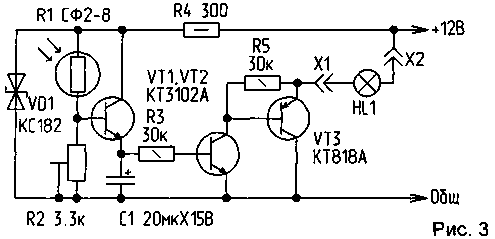
|
|
ENCYCLOPEDIA OF RADIO ELECTRONICS AND ELECTRICAL ENGINEERING Automatic anti-dazzle lamp. Encyclopedia of radio electronics and electrical engineering
Encyclopedia of radio electronics and electrical engineering / Automobile. Electronic devices At night, on the roads you can find cars in which a blue or green flashlight shines on the windshield at the top left. This is one of the anti-dazzle devices. To improve its efficiency, the following scheme is proposed. Consider the usefulness of an automobile anti-dazzle device for the driver. The graph (Fig. 1) of the intensity distribution of the radiant flux of an incandescent lamp [1] shows that its largest part is made up of red, orange and yellow rays, which mainly illuminate the retina of the driver's eyes. In order to "cut off" the brightest part of the spectrum of car headlights, many drivers install passive light filters from stripes of blue or green plexiglass at the top of the windshield. However, passive filters are very inconvenient, because. located above the main field of view of the driver.
An electric anti-dazzle lamp is installed at the level of the main field of vision of the driver, on the left side of the windshield, which practically does not interfere with the driver when driving. The light from the lamp spreads parallel to the windshield and does not fall into the driver's eye, for this the lamp has a light-protective visor. When the flashlight is turned on, a significant part of the radiant flux of headlights is absorbed, reducing the illumination of the retina. In addition, the use of a blue or green light filter in a flashlight makes it possible to control the situation on the road, since at night the human eyes are most sensitive to blue and green rays (Fig. 2) of the visible spectrum [1].
The disadvantage of manufactured anti-glare lamps is their early or late inclusion. Late switching on is especially dangerous, when the retina of the eyes is illuminated from a sharp bright light, and turning on the flashlight is ineffective. The proposed scheme for automatically turning on and off the lamp has the following advantages over the one published in [2]: - the whole device is turned on simultaneously with the headlights of the car from its "regular" switch;
Figure 3 shows a schematic diagram of an automatic device for turning on and off an anti-glare lamp. It consists of a threshold luminous flux amplifier on a transistor VT1, a composite transistor switch on transistors of different conductivity VT2, VT3 and a delay circuit for turning off the lamp HL1, made on a resistor R3 and a storage capacitor C1. The device is powered by a parametric stabilizer on the zener diode VD1 and resistor R4. The device is switched on together with the headlights of the car. As soon as the rays of light from the headlights of oncoming traffic hit the photoresistor R1, the transistor VT1 opens, which turns on the transistor key VT2, VT3, and the onboard voltage of +1 V is supplied to the HL12 lamp lamp - the lamp starts to shine. At this time, the capacitor C1 is simultaneously charged. When the lighting of the photoresistor stops, the transistor VT1 closes, but the lamp HL1 continues to shine until the storage capacitor C1 is completely discharged through the resistor R3 and the base-emitter junction of the transistor VT2. The trimming resistor R2 sets the threshold for turning on the lantern lamp HL1. Structurally, the printed circuit board is located in the lamp housing. For the photoresistor, a hole is drilled in the housing from the side facing the road. Although the sensitivity of the circuit is sufficient, in order to increase its efficiency, it is desirable to install a converging lens in front of the photoresistor. The optical system (photoresistor with a lens) is positioned so that it is well illuminated by the headlights of oncoming vehicles and as little as possible by the headlights of your own car. The power of the lamp in the lamp should not exceed 5 W, the photoresistor R1 of the SF2-8 type can be replaced with an FSK-1 with a dark resistance of 30 ... 60 kOhm, transistors VT1, VT2 must have a static current transfer coefficient of at least 100. radiator and can be replaced by KT3 with any letter. Capacitor C818 type K1-50 can be replaced with any capacitance of 16 ... 20 microfarads. Trimmer resistor R30 - type SPZ-2A. Zener diode VD6 KS 1 can be replaced with D182A.B. Literature 1. Enohovich A.S. Brief reference book on physics. - M.: Higher school, 1969.-S. 111, 114. Author: P.Belyatsky, Novosibirsk region, Berdsk; Publication: N. Bolshakov, rf.atnn.ru
Artificial leather for touch emulation
15.04.2024 Petgugu Global cat litter
15.04.2024 The attractiveness of caring men
14.04.2024
▪ New IEEE 802.15.4 Transceiver CC2520 for ZigBee Networks ▪ MAX44205 and MAX44206 - new low-noise differential op amps ▪ GeForce GTX 1650 Low Profile Accelerators ▪ Volvo car detects animals on the road
▪ section of the site Calls and audio simulators. Article selection ▪ article by Thomas Stearns Eliot. Famous aphorisms ▪ article Where did olives come from? Detailed answer ▪ electrical injury article. Health care ▪ article Spiral antenna. Encyclopedia of radio electronics and electrical engineering ▪ article Tester of small batteries. Encyclopedia of radio electronics and electrical engineering
Home page | Library | Articles | Website map | Site Reviews www.diagram.com.ua |






 Arabic
Arabic Bengali
Bengali Chinese
Chinese English
English French
French German
German Hebrew
Hebrew Hindi
Hindi Italian
Italian Japanese
Japanese Korean
Korean Malay
Malay Polish
Polish Portuguese
Portuguese Spanish
Spanish Turkish
Turkish Ukrainian
Ukrainian Vietnamese
Vietnamese



 Leave your comment on this article:
Leave your comment on this article: